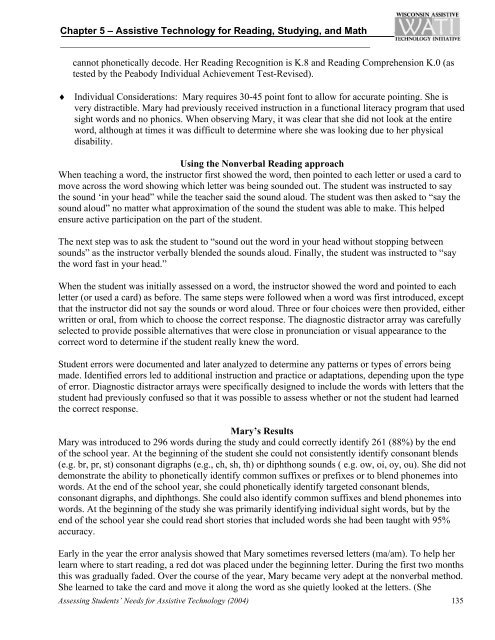Assessing Student's Needs for Assistive Technology (ASNAT)
Assessing Student's Needs for Assistive Technology (ASNAT)
Assessing Student's Needs for Assistive Technology (ASNAT)
You also want an ePaper? Increase the reach of your titles
YUMPU automatically turns print PDFs into web optimized ePapers that Google loves.
Chapter 5 – <strong>Assistive</strong> <strong>Technology</strong> <strong>for</strong> Reading, Studying, and Math<br />
cannot phonetically decode. Her Reading Recognition is K.8 and Reading Comprehension K.0 (as<br />
tested by the Peabody Individual Achievement Test-Revised).<br />
♦ Individual Considerations: Mary requires 30-45 point font to allow <strong>for</strong> accurate pointing. She is<br />
very distractible. Mary had previously received instruction in a functional literacy program that used<br />
sight words and no phonics. When observing Mary, it was clear that she did not look at the entire<br />
word, although at times it was difficult to determine where she was looking due to her physical<br />
disability.<br />
Using the Nonverbal Reading approach<br />
When teaching a word, the instructor first showed the word, then pointed to each letter or used a card to<br />
move across the word showing which letter was being sounded out. The student was instructed to say<br />
the sound ‘in your head” while the teacher said the sound aloud. The student was then asked to “say the<br />
sound aloud” no matter what approximation of the sound the student was able to make. This helped<br />
ensure active participation on the part of the student.<br />
The next step was to ask the student to “sound out the word in your head without stopping between<br />
sounds” as the instructor verbally blended the sounds aloud. Finally, the student was instructed to “say<br />
the word fast in your head.”<br />
When the student was initially assessed on a word, the instructor showed the word and pointed to each<br />
letter (or used a card) as be<strong>for</strong>e. The same steps were followed when a word was first introduced, except<br />
that the instructor did not say the sounds or word aloud. Three or four choices were then provided, either<br />
written or oral, from which to choose the correct response. The diagnostic distractor array was carefully<br />
selected to provide possible alternatives that were close in pronunciation or visual appearance to the<br />
correct word to determine if the student really knew the word.<br />
Student errors were documented and later analyzed to determine any patterns or types of errors being<br />
made. Identified errors led to additional instruction and practice or adaptations, depending upon the type<br />
of error. Diagnostic distractor arrays were specifically designed to include the words with letters that the<br />
student had previously confused so that it was possible to assess whether or not the student had learned<br />
the correct response.<br />
Mary’s Results<br />
Mary was introduced to 296 words during the study and could correctly identify 261 (88%) by the end<br />
of the school year. At the beginning of the student she could not consistently identify consonant blends<br />
(e.g. br, pr, st) consonant digraphs (e.g., ch, sh, th) or diphthong sounds ( e.g. ow, oi, oy, ou). She did not<br />
demonstrate the ability to phonetically identify common suffixes or prefixes or to blend phonemes into<br />
words. At the end of the school year, she could phonetically identify targeted consonant blends,<br />
consonant digraphs, and diphthongs. She could also identify common suffixes and blend phonemes into<br />
words. At the beginning of the study she was primarily identifying individual sight words, but by the<br />
end of the school year she could read short stories that included words she had been taught with 95%<br />
accuracy.<br />
Early in the year the error analysis showed that Mary sometimes reversed letters (ma/am). To help her<br />
learn where to start reading, a red dot was placed under the beginning letter. During the first two months<br />
this was gradually faded. Over the course of the year, Mary became very adept at the nonverbal method.<br />
She learned to take the card and move it along the word as she quietly looked at the letters. (She<br />
<strong>Assessing</strong> Students’ <strong>Needs</strong> <strong>for</strong> <strong>Assistive</strong> <strong>Technology</strong> (2004) 135











